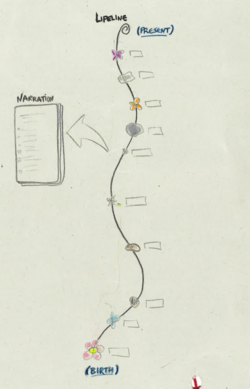Medicine:Narrative exposure therapy
Narrative exposure therapy (NET) is a short-term psychotherapy used for the treatment of post-traumatic stress disorder and other trauma-related mental disorders.[1][2] It creates a written account of the traumatic experiences of a patient or group of patients, with the aim of recapturing self-respect and acknowledging the patient's value. Under this name it is used mainly with refugees, individually or within small groups.[3] NET was created in Germany in the early 2000s.[4]

Key elements
Lifeline
NET is conducted around the use of the lifeline, which serves as both a reference point for the therapist and the patient during the therapy. Different symbols are used to reconstitute the patient's lifeline, especially flowers and stones. Flowers are used to represent good/positive events, whereas stones are the bad/negative events of the patient's life. Size, shape and colour of symbols may also be used to indicate events with greater or lesser intensity or significance. It is up to the patient to decide on placing and choosing these symbols to reconstitute his/her lifeline. The biggest stones are then chosen to be dealt with, since they represent the greatest traumas that the patient need to reprocess or overcome.
Narration
Narrations are a product of the therapy. In the end of a therapy, the narration is read and given to the patient. It is supposed to be a representative summary of the patient's life, even including some details. Narrations are expected to be taken by the patient to help him/her overcome his trauma and mental problems. Narrations are helpful for the patient to re-process his/her memories of the past, particularly the trauma, and reorganize his/her thoughts, which should ultimately reduce the recurrence of bad memories that are responsible for the suffering of to the patient.
Adaptations
- NET: aimed at a general public
- KidNET: aimed at children and adolescents[5][6][7]
- FORNET: aimed at perpetrators[8][9][10]
Efficacy
Studies have shown NET to reduce symptoms of post-traumatic stress disorder and depression, but few comparisons have been made to other available treatments.[1]
It is conditionally recommended for treatment of PTSD by the American Psychological Association.[3]
See also
References cited
- ↑ 1.0 1.1 "The effectiveness of narrative exposure therapy: a review, meta-analysis and meta-regression analysis". European Journal of Psychotraumatology 10 (1): 1550344. 2019-12-31. doi:10.1080/20008198.2018.1550344. PMID 31007868.
- ↑ "The emerging evidence for Narrative Exposure Therapy: a review". Clinical Psychology Review 30 (8): 1030–9. December 2010. doi:10.1016/j.cpr.2010.07.004. PMID 20832922.
- ↑ 3.0 3.1 "Narrative Exposure Therapy (NET)". Clinical Practice Guideline for the Treatment of Posttraumatic Stress Disorder (PTSD). American Psychological Association. https://www.apa.org/ptsd-guideline/treatments/narrative-exposure-therapy.
- ↑ Narrative exposure therapy: a short-term treatment for traumatic stress disorders.. Cambridge, MA: Hogrefe. 2011. ISBN 978-0-88937-388-4.
- ↑ "Narrative exposure therapy for the treatment of traumatized children and adolescents (KidNET): from neurocognitive theory to field intervention". Child and Adolescent Psychiatric Clinics of North America 17 (3): 641–64. July 2008. doi:10.1016/j.chc.2008.03.001. PMID 18558317. http://nbn-resolving.de/urn:nbn:de:bsz:352-opus-85645.
- ↑ "KIDNET–Narrative Expositionstherapie (NET) für Kinder.". Traumatherapie bei Kindern und Jugendlichen. 1. 2008. pp. 84–110. ISBN 978-3-8409-2332-6.
- ↑ "Narrative exposure therapy for children and adolescents (KIDNET)". Evidence-based treatments for trauma related disorders in children and adolescents. Springer, Cham. 2017. pp. 227–250.
- ↑ "Treating Traumatized Offenders and Veterans by Means of Narrative Exposure Therapy". Frontiers in Psychiatry 6: 80. 2015. doi:10.3389/fpsyt.2015.00080. PMID 26157395.
- ↑ "Addressing post-traumatic stress and aggression by means of narrative exposure: a randomized controlled trial with ex-combatants in the Eastern DRC". Journal of Aggression, Maltreatment & Trauma 22 (8): 916–934. 2013. doi:10.1080/10926771.2013.824057. http://nbn-resolving.de/urn:nbn:de:bsz:352-251800.
- ↑ "The treatment of posttraumatic stress symptoms and aggression in female former child soldiers using adapted Narrative Exposure therapy - a RCT in Eastern Democratic Republic of Congo". Behaviour Research and Therapy 123: 103482. December 2019. doi:10.1016/j.brat.2019.103482. PMID 31639529.
External links
- "Narrative Exposure Therapy (NET)". vivo international. https://www.vivo.org/en/narrative-expositionstherapie/.
